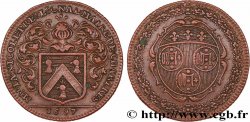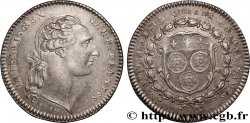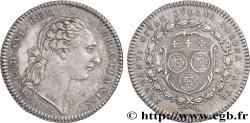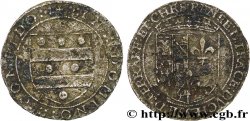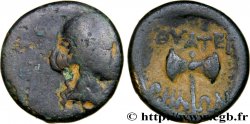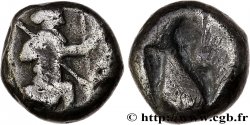fjt_209094 - CHARTRES ET LE PAYS CHARTRAIN Louis Guillard, évêque de Chartres n.d.
non disponibile.
Articolo venduto sul nostro negozio (2011)
Prezzo : 290.00 €
Articolo venduto sul nostro negozio (2011)
Prezzo : 290.00 €
Tipo : Louis Guillard, évêque de Chartres
Data: n.d.
Metallo : ottone
Diametro : 27 mm
Asse di coniazione : 12 h.
Peso : 3,98 g.
Orlo : lisse
Grado di rarità : R2
Commenti sullo stato di conservazione:
Peu d’usure mais gravure de faible relief, normale pour l’époque
N° nelle opere di riferimento :
Diritto
Titolatura diritto : VICTRIX. FORTUNE. PATIENTIA. *..
Descrittivo diritto : Écu aux armes de Guillard posé sur une crosse et soutenu par deux aigles.
Traduzione diritto : (Une patience qui triomphe avec bonheur).
Rovescio
Titolatura rovescio : +: PRO: LEGE: ET: GREGE: MORERE:.
Descrittivo rovescio : Un pélican dans son aire.
Traduzione rovescio : (Mourir pour la loi et pour son nid).
Commento
Louis Guillard fut évêque élu de Tournai de 1513 à 1525 ; évêque de Chartes de 1525 à 1553 puis fut transféré à Châlon en 1553 et en 1560 à Senlis. Les armes de Guillard portent de gueules, à deux bourdons de pèlerins d’or posés en chevron, accompagné de trois monts d’argent. Louis et Charles Guillard, oncle et neveu, furent évêques de Chartres. Tous deux furent concernés par l'expansion de l'hérésie dans le diocèse. Le premier fut un administrateur ferme et publia en 1550 des statuts synodaux qui annonçaient déjà la Contre-Réforme. Son neveu Charles, qui le remplaça en 1553, fut accusé de complaisance envers les Réformés, bien que quelques bûchers aient marqué ses débuts. En 1572, il était devenu si détesté par les Chartrains, très attachés à l'orthodoxie, qu'il dut se démettre. Il n'y eut en revanche dans le diocèse aucune persécution liée à la Saint-Barthélémy.
Louis Guillard was elected bishop of Tournai from 1513 to 1525; bishop of Chartres from 1525 to 1553, then transferred to Châlon in 1553 and to Senlis in 1560. Guillard's coat of arms is gules, with two golden pilgrim's staffs placed in a chevron, accompanied by three silver mounts. Louis and Charles Guillard, uncle and nephew, were bishops of Chartres. Both were involved in the spread of heresy in the diocese. The former was a firm administrator and published synodal statutes in 1550 that already foreshadowed the Counter-Reformation. His nephew Charles, who replaced him in 1553, was accused of being complacent towards the Reformed, although a few pyres marked its beginnings. By 1572, he had become so hated by the people of Chartres, who were very attached to orthodoxy, that he had to resign. However, there was no persecution in the diocese linked to Saint Bartholomew's Day.
Louis Guillard was elected bishop of Tournai from 1513 to 1525; bishop of Chartres from 1525 to 1553, then transferred to Châlon in 1553 and to Senlis in 1560. Guillard's coat of arms is gules, with two golden pilgrim's staffs placed in a chevron, accompanied by three silver mounts. Louis and Charles Guillard, uncle and nephew, were bishops of Chartres. Both were involved in the spread of heresy in the diocese. The former was a firm administrator and published synodal statutes in 1550 that already foreshadowed the Counter-Reformation. His nephew Charles, who replaced him in 1553, was accused of being complacent towards the Reformed, although a few pyres marked its beginnings. By 1572, he had become so hated by the people of Chartres, who were very attached to orthodoxy, that he had to resign. However, there was no persecution in the diocese linked to Saint Bartholomew's Day.








 Segnalare un errore
Segnalare un errore Stampate la pagina
Stampate la pagina Condividi mia selezione
Condividi mia selezione Fai una domanda
Fai una domanda Consegnare / vendere
Consegnare / vendere
 Descrittivo
Descrittivo